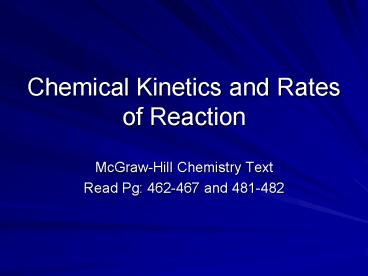Chemical Kinetics and Rates of Reaction - PowerPoint PPT Presentation
1 / 21
Title:
Chemical Kinetics and Rates of Reaction
Description:
The study of rates of chemical reactions and the mechanisms (or steps) by which ... (metal and non-metal bonded) will take the most time because the strong ionic ... – PowerPoint PPT presentation
Number of Views:90
Avg rating:3.0/5.0
Title: Chemical Kinetics and Rates of Reaction
1
Chemical Kinetics and Rates of Reaction
- McGraw-Hill Chemistry Text
- Read Pg 462-467 and 481-482
2
Chemical Kinetics
- The study of rates of chemical reactions and the
mechanisms (or steps) by which a chemical
reaction takes place. - Reaction rates vary greatly some are very fast
(burning) and some are very slow (disintegration
of a plastic bottle in sunlight).
3
- Rate of reaction the change in concentration of
a reactant or product per unit of time. - Rxn Rate (avg) ? reactant or product
- ? time
- Note square brackets mol/L
4
Example problem
- If the concentration of reactant X after 50 s in
a reaction was 0.0079 mol/L and after 100 s was
0.0065 mol/L, calculate the average reaction
rate. - Rate ?X / ?t
- (0.0065 0.0079 M) / (100-50 s)
- - 0.000028 M/s
5
- Concentration of reactant decreases with time, as
it is being used up - The rate is fastest when concentration of
reactants is greatest and slows when
concentration of reactants are less
6
- The reactants are being used up as the reaction
takes place. - Whats happening to the concentration of products
over time? - It is increasing.
7
- In the beginning of the reaction, product is
formed quickly, but slows over time because less
reactants means less reactants collisions
producing the new product.
Concentration of product (mol/L)
Time (s)
8
Factors that affect the Rate
- Concentration (and pressure)
- Temperature
- Amount of surface area
- Catalysts
- Nature of reactants
9
Concentration
- A higher concentration of reactants leads to more
effective collisions per unit time, which leads
to an increasing reaction rate - We are not increasing the amount being made for a
given balanced equation with limiting reactants,
we are only speeding up how quickly those
products are made.
10
Pressure
- affects the rate of reaction, especially when you
look at gases. - When you increase the pressure, the molecules
have less space in which they can move. That
greater concentration of molecules increases the
number of collisions. - When you decrease the pressure, molecules don't
hit each other as often. The lower pressure
decreases the rate of reaction
11
Temperature
- Temperature is a measure of the kinetic energy of
a system, so higher temperature implies higher
average kinetic energy of molecules and more
collisions per unit time.
12
Surface Area
- Reducing the size of particles increases the rate
of a reaction because it increases the surface
area available for collisions to take place. This
increases the number of collisions.
13
Catalysts
- A catalyst is a substance that speeds up a
reaction without being used up itself. - Some reactions have catalysts that can speed them
up, but for many reactions there is no catalyst
that works. - How do they work?
14
1. A catalyst provides a surface on which the
reaction can take place.
- One or more reactants are adsorbed to the surface
(stick to it) - Lets look at the example of ethene undergoing
hydrogenation (breaking double bond and making
single bonds while adding hydrogen) - Usually VERY slow
15
- Interaction between the catalyst and the reactant
(maybe weakening bonds, or an actual reaction
with the surface) - The reactants may collide on the catalyst or one
is prepared and then collide together
16
- The product is desorbed, breaks away from the
catalyst once formed - Nickel and platinum are excellent heterogeneous
catalysts. They dont adsorbed too much or too
little. - Hydrogenation of vegetable oil to make margarine
uses a nickel catalyst
17
2) A catalyst lowers the activation energy
- AE the minimum amount of energy needed for a
reaction to take place. - Reactants require less energy to react.
- By providing an alternative mechanism (step in
the reaction) - Sometimes catalysts seem to be used up, but they
will regenerate at the end of the reaction
18
Nature of Reactants
- Reactants with large number of chemical bonds
that have to be broken, or with strong chemical
bonds that have to be broken, will lead to a
slower rate. - The strong bonds will cause a high activation
energy, leading fewer collisions being
successful.
19
- More complex reactant molecules with more atoms,
will have more difficulty lining up properly to
have a successful reaction. This will also lead
to a lower reaction rate.
20
Good rule of thumb
- Ions will react more quickly, because already
broken up. - Simple molecules (non-metals covalently bonded)
will take more time - Complex molecules and ionic compounds (metal and
non-metal bonded) will take the most time because
the strong ionic bonds need lots of energy to be
broken, and the complex molecules will be hard to
have proper geometry (line up)
21
Practice
- Place the following reactions from fastest to
slowest, based on the previous slides. - 2Cu2 2I- ? 2 Cu I2
- 2NaCl ? 2Na Cl2
- Cl2 ? 2Cl
Ans 1 is fastest, then 3, and 2 is slowest

